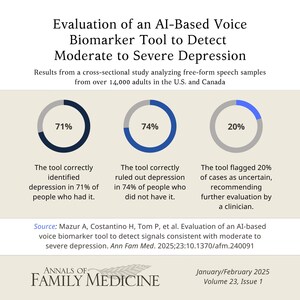PROVIDENCE, R.I., Aug. 28, 2024 /PRNewswire/ -- A new study published in Annals of Family Medicine has found an increased rate of gonorrhea incidence among gay, bisexual, and other men who have sex with men (GBM) in Ontario who use pre-exposure prophylaxis (PrEP) compared to non-users. Titled "Self-Reported PrEP Use and Risk of Bacterial STIs Among Ontarian Men Who Are Gay or Bisexual or Have Sex With Men," this research sheds light on the complex relationship between PrEP use and the incidence of bacterial sexually transmitted infections (STIs). The study emphasizes the need for comprehensive sexual health services for those taking PrEP.
PrEP is an antiviral treatment that suppresses the HIV virus but has no effect on bacterial infections such as gonorrhea, chlamydia, and syphilis. While there is concern that PrEP use may be associated with an increase in bacterial sexually transmitted infections (STIs) among GBM, the reasons for this association are complex. This study aimed to explore the relationship between PrEP use and the rates of bacterial sexually transmitted infections over time.
Researchers used data from the iCruise Study, an online longitudinal study conducted between July 2017 and April 2018. The study included 659 randomly selected GBM participants who completed weekly diary surveys over a three-month period. The survey tracked instances of chlamydia, gonorrhea, and syphilis infections, measuring infection rates as the number of infections per 100 months of participant observation time.
Key Findings:
A total of 535 participants were included in the final analysis, contributing 1,623.5 person-months of data. Among these participants, 13.1% (70 participants) reported using PrEP during the study period.
- PrEP use was linked to a higher rate of gonorrhea: The initial analysis suggested that the rate of gonorrhea among PrEP users was four times higher than among non-users, with an incidence rate ratio of 4.00 (95% confidence interval: 1.67–9.58). After conducting a bias analysis to account for potential inaccuracies in self-reported data, the association remained, though it was somewhat less pronounced. The adjusted analysis showed that rates of gonorrhea were still higher among PrEP users, with a median incidence rate ratio of 2.36 (simulation interval: 1.08–5.06).
- There was no significant increase in the rates of chlamydia or syphilis among PrEP users.
Individuals who choose to take PrEP are at higher risk for gonorrhea and should be regularly tested and treated to manage this risk effectively. The findings of this study highlight the importance of investing in sexually transmitted infection testing, risk reduction, secondary prevention measures such as Doxycycline Post-Exposure Prophylaxis (a preventive treatment to reduce the risk of bacterial STIs after potential exposure), surveillance, and partner management alongside PrEP to reduce bacterial STI transmission effectively. This approach is necessary regardless of whether the increased risk is due to pre-existing factors or potential behavior changes associated with PrEP use.
Article Cited:
Nguyen K. Tran, PhD, MPH; Seth L. Welles, PhD, ScD; Jason A. Roy, PhD; David J. Brennan, PhD; Esther Chernak, MD, MPH; and Neal D. Goldstein, PhD, MBI
Annals of Family Medicine is a peer-reviewed, indexed research journal that provides a cross-disciplinary forum for new, evidence-based information affecting the primary care disciplines. Launched in May 2003, Annals of Family Medicine is sponsored by seven family medical organizations, including the American Academy of Family Physicians, the American Board of Family Medicine, the Society of Teachers of Family Medicine, the Association of Departments of Family Medicine, the Association of Family Medicine Residency Directors, the North American Primary Care Research Group, and the College of Family Physicians of Canada. Annals of Family Medicine is published online six times each year and contains original research from the clinical, biomedical, social, and health services areas, as well as contributions on methodology and theory, selected reviews, essays, and editorials. Complete editorial content and interactive discussion groups for each published article can be accessed for free on the journal's website, www.AnnFamMed.org.
SOURCE Annals of Family Medicine

WANT YOUR COMPANY'S NEWS FEATURED ON PRNEWSWIRE.COM?
Newsrooms &
Influencers
Digital Media
Outlets
Journalists
Opted In






Share this article